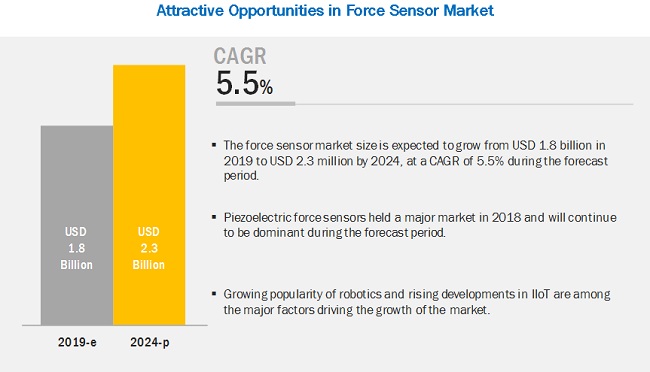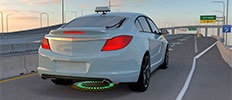The force sensor market size is expected to grow from USD 1.8 billion in 2019 to USD 2.3 billion by 2024, at a CAGR of 5.5%. The drivers fueling the growth of the market are rising demand for industrial robots and growing safety features in automobiles.
The market for manufacturing applications accounted for the largest size in 2018. The large market size is attributed to automobile component manufacturers who are striving to bring innovation in the industry by having an optimum production plan of manufacturing the highest quality automobiles and its spare parts. Automotive manufacturing involves a large number of manufacturing and assembling activities requiring force sensors.
The market for analog force sensors is estimated to account for a larger share of the overall force sensor market, by operation, in 2018. Analog force sensor is the most commonly used technology. The analog load cells use strain gauge for measuring strain or compression applied by the load. In an analog load cell, a strain gauge is attached to the spring element of the load cell. The strain gauge is the most important component of an analog load cell. The strain gauge is constructed in sections using thin metal pieces. The thinner the metal piece, the finer would be the readings of load. However, the thin metals are also prone to damage due to rough handling, which could damage the strain gauge and cause errors in readings for load monitoring.

Download PDF Brochure @
https://www.marketsandmarkets.com/pdfdownloadNew.asp?id=16792450
The market for compression and tension-based force type is estimated to account for the largest share of the overall force sensor market in 2018. Force sensors are generally capable of detecting compression force, tension force, or the combination of both. Compression force-based sensors are the sensors that can detect the application of power, pressure, or exertion against the sensor that leads to it getting squeezed, squashed, or compacted. Tension-based force sensors detect the force acting perpendicular to a sensor or a force that tries to tear off the sensor by separating it. The majority of the available force sensors, including piezoelectric, capacitive, strain gauge, and magnetoeleastic force sensor, are capable of detecting both compression and tension force, while only load cells are generally classified as compression type or tension type depending on the application.
Piezoelectric force sensor held the largest share of the force sensor market in 2018. Piezoelectric sensors detect changes in pressure, acceleration, temperature, strain, and force and convert the acquired data to an electrical charge. Hence, it is mostly used in applications involving flex motions, touch, vibrations, and shock measurement. Piezoelectric sensors are used in various industries, such as healthcare, aerospace, and consumer electronics, as well as nuclear instrumentation.
In terms of value, APAC led the force sensor market in 2018, accounting for the largest share of the overall force sensor market, by region. APAC is the largest market for force sensors owing to China’s largest manufacturing output. It is one of the largest manufacturers of consumer electronics, automobile, mining, and other machinery. After APAC, North America is expected to grow during the forecast period owing to the high adoption of Industrial Internet of Things (IIoT) and Industry 4.0 in North American factories, specifically in the US.
